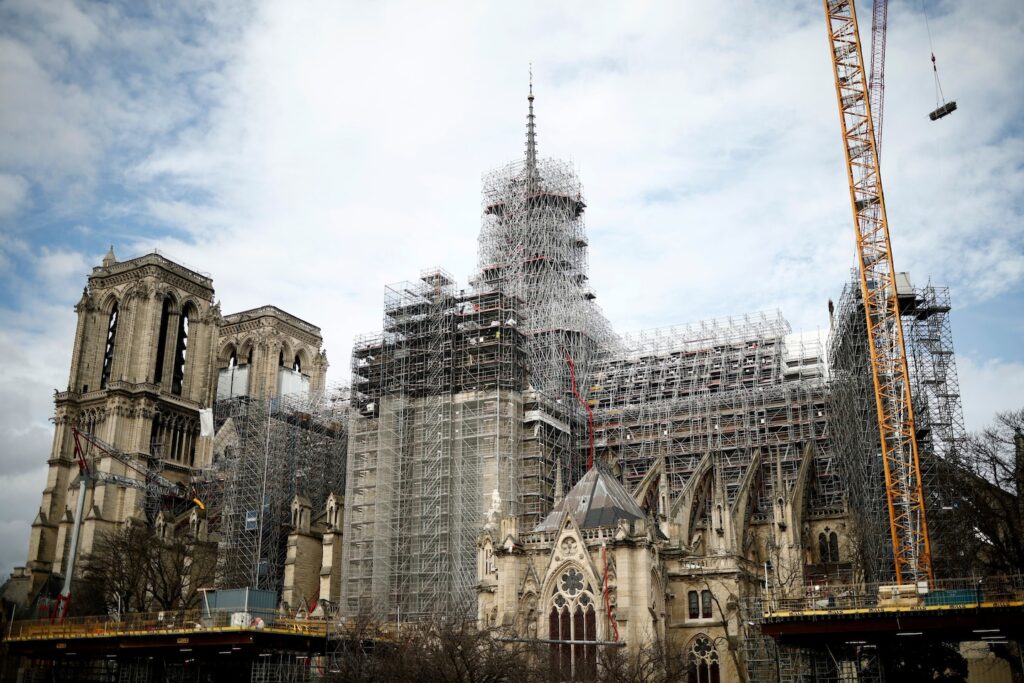Notre Dame Cathedral is scheduled to reopen on December 8 for the first time since the fire, which also damaged the roof and part of the vault.The cause of the fire is not clear, but an initial investigation in 2019 suggested a cause for the fire. This may be caused by an electrical system failure during renovation work.
French President Emmanuel Macron celebrated the development on social media: “She has appeared in the sky again!” It's France's pride. ”
Jennifer Feltman, a medieval art historian at the University of Alabama and part of the official team studying Notre Dame's restoration, said in a phone interview that the unveiling was “absolutely remarkable.” . “It took a lot of dedication for them to get to this point,” she said.
This inferno left a cathedral-shaped hole in the Paris skyline and a void in the city's history and heart. In the rebirth of the spire, many people were happy to see what was lost returned, but not everyone. The unveiling also marks the final chapter in a heated debate over how to restore the famous structure. For some, recreating the 19th century spire was essential. Meanwhile, for others, imitating history risked erasing ourselves, and our 21st century design sensibilities, from history.
The new structure is largely a reproduction. Friends of Notre Dame, a non-profit organization raising funds for the cathedral's reconstruction, says on its website that the spire “is similar in appearance, material (lead-covered oak frame), and construction methods used to It is the same as the spire of The Golden Rooster is an exception, having been reimagined in the style of a flaming-winged phoenix by the reconstruction's chief architect. Philippe Villeneuve. Previously another rooster stood on the spire. This bird is considered a symbol of France.
The spire of Notre Dame Cathedral has gone through several chapters in its nearly 800-year history. The original spire was built around 1250 and was used as a bell tower in the 1600s, but was removed in the late 1700s because it was in danger of decaying and collapsing. For decades, the cathedral remained without a spire. Then, in the mid-19th century, architect Eugène Emmanuel Viollet-le-Duc designed a new spire, which existed until a fire broke out.
Meredith Cohen, a medieval architectural historian at UCLA, praised those responsible for the restoration for their transparency and documentation. But she said in her phone call that she was “a little ambivalent” about the revelation.
Although construction began in 1163, Notre-Dame Cathedral was not considered nearly complete until 1345, and many additions and changes were made thereafter. As the cathedral was built, the builders added and restored elements in the style of the time, Cohen said. I got it. Paradoxically, “if we had taken a medieval approach to this medieval building, we would restore it in a modern style,” she said.
Cohen acknowledged that while the public might want to see the beloved 19th-century spire restored, it's not possible. She says it's a “21st century spire just built to look like a 19th century spire.” “It’s playing around with history a little bit and it’s not visually transparent.”
Cohen is not alone in this view. Many modern interpretations of the spire were proposed, but not all were serious. And at one point, that approach was proposed by Macron. But the reconstruction's chief architect, Mr. Villeneuve, said he would rather resign than allow the construction of a modern spire, the Post reported.
Feltman, the Alabama professor, said modern technology allowed architects to rebuild the spire with such fidelity. She points to the “incredibly accurate documentation” that comes from digital scans. “Even when we recreate the 19th century, we are implicitly creating something modern,” she said.
There's something medieval about the drama of watching the cathedrals come together, Feltman added. “I think it gave us a little bit of insight into a part of the past that not many people know about anymore.” And for many, this week's revelations were the high point.


